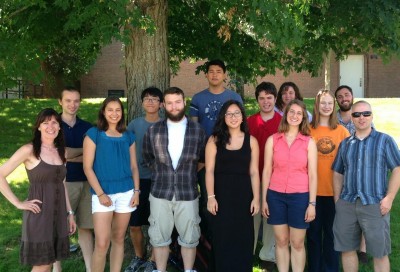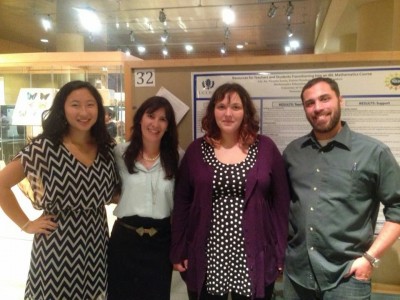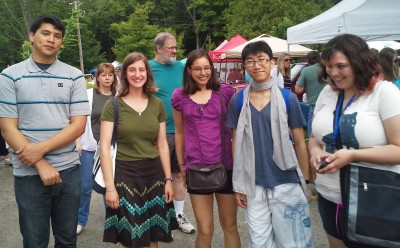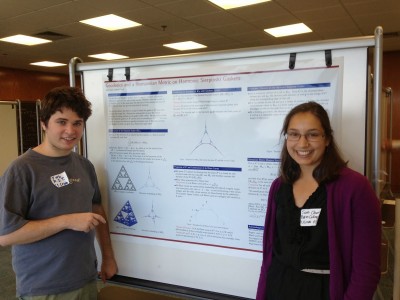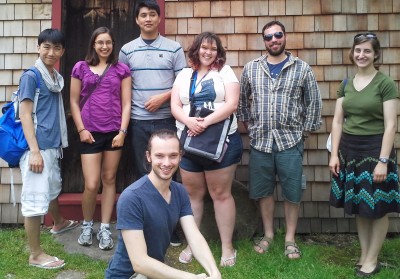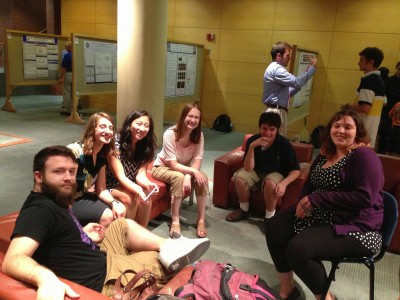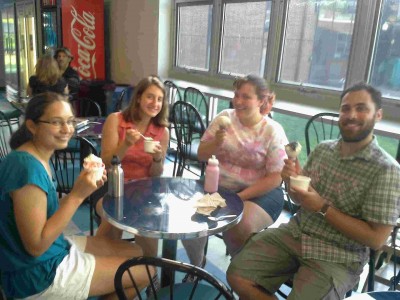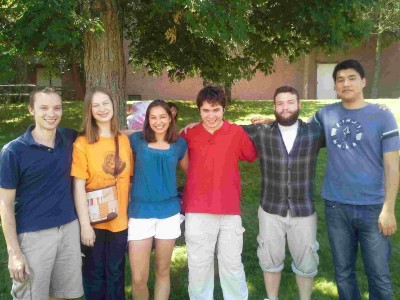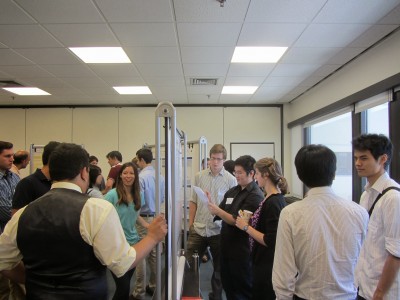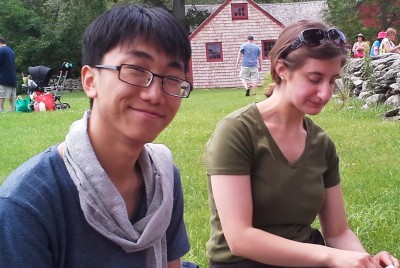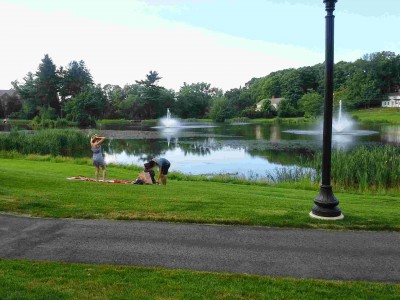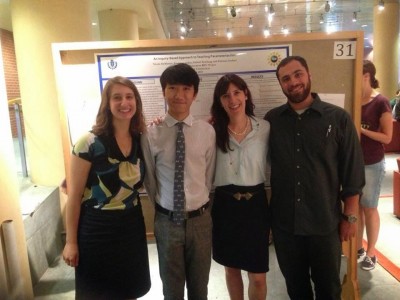Research
Goals
The primary function of our program is to involve undergraduate students in mathematical research. The summer of 2013, there were two research groups running two projects a piece for a total of 4 projects. Students had contact with senior researchers five days a week for 9 weeks with one day a week for the students to get an opportunity to update the rest of the program on their progress. Each project had an aspect of presenting the research, whether that meant preparing a paper for publication or presenting for other students and colleagues. This included either a presentation or a poster at a symposium among the REU funded programs in other disciplines and a symposium held at UMass Amherst by nearby REU funded programs in mathematics (UConn, UMass, Smith, Mt Holyoke, Williams, Yale).
Spectrum of the Magnetic Laplacian on the Sierpinski Gasket (Project Link)
One project investigated magnetic gauge fields on the Sierpinski Gasket. After numerical experimentation, using Mathematica and MatLab, this team determined that specific portions of the spectrum of the Laplacian are unaffected by a perturbing magnetic field given by a harmonic 1-form of finite topological type and continued on to prove this. In a specific case they also gave a description of the spectrum via a covering space and symmetry argument. They presented a poster and a talk on this work at the REU mini-conference at the University of Massachusetts, Amherst and gave a talk at the Young Mathematician’s Conference at Ohio State University. They are working on a publication version.
Measurable Riemannian Structure on Higher Dimensional Sierpinski Gaskets (Project Link)
The other team worked on the existence of measurable Riemannian structures in the sense of Kigami on higher dimensional Sierpinski-type gaskets. Some time ago, Kusuoka proved existence of a measure, metric (in the Riemannian sense), and gradient operator on a class of fractals that includes these gaskets such that these objects bear the same relation to the Dirichlet form as do the Riemannian volume, metric, and gradient on Euclidean space. Kigami later completed this picture in the case of the usual 3-vertex Sierpinski gasket by constructing a geodesic length that is the analogue of that occurring in the Riemannian case and proving Gaussian heat kernel estimates, and Kajino has subsequently proved very re ned estimates for the heat kernel in this setting. It was believed that although Kigami’s approach relied on certain 2-dimensional techniques, the results would also be valid on Sierpinski-type gaskets with more vertices, and that is what our research team has proved. They presented a poster on this work at the REU mini-conference at the University of Massachusetts, Amherst, and are writing the results up for publication.
Resources to Aid the Transition into an IBL Mathematics Course (Project Link)
This group conducted a research study to create resources to support both instructors and students transition into an Inquiry-based learning (IBL) course. The IBL approach has been shown to deepen student conceptual learning and increase student engagement and motivation in a subject without taking away from procedural understanding. The experiences in an IBL class are significantly different from traditional courses; however, there are few research-based resources to aid instructors and college students adapt to this approach. For this project, the creation of such resources was guided by extensive review of the literature as well as informed by experienced instructors teaching undergraduate mathematics courses and students who had positive and negative experiences in IBL courses. These methods along with the group’s experiences and expertise as instructors and undergraduate students of mathematics helped determine specific aspects that would be most challenging for an instructor, as well as the difficulties students would face, in the transition to an IBL course. The results of this study include a teacher’s guide and a student’s guide that address those difficulties, provide guidance for each audience, and contribute suggestions to achieve the desired learning outcomes of an IBL course.
An Inquiry-Based Approach to Teaching Parameterization (Project Link)
In the summer of 2012, the UConn Math Education REU team identified parameterization of curves as a challenging topic for students in multivariable calculus courses. Encouraged by the positive research results of inquiry-based learning (IBL) on student performance and attitudes, the research focus for the group in 2013 was to develop IBL curricular materials aimed at supporting student’s understanding of this topic. The group conducted an extensive literature review, studied popular multivariable calculus textbooks, and consulted with experienced instructors to create an original IBL module. The module engages students in collaborative discovery to gain a deep conceptual understanding of parameterization in addition to providing opportunities for procedural practice. In addition, the group developed a detailed guide to support instructors in the effective classroom implementation of the module.
Academic Development
Goals
Aiding the students in their academic development is a key goal of our program, as it forms a solid foundation for a career in math and science. Advancing students in their academic background comes in several forms, broadening the knowledge base, understanding the flow of academic life, and best practices for research.
Seminars
This summer we expanded our accompanying lecture series. Throughout the course of the summer we invited experienced researchers to give talks about their work or other subjects that interested them. In total, 13 seminars were held. As last year, tutorials were held in the computer algebra language Mathematica and the typesetting language LaTeX. Both of these computer systems are useful to learn for anyone who wishes to publish scholarly scientific articles, and and both were used by all of our students for writing up and presenting their work. New this year were multi-lecture mini-courses to five a more in-depth introduction to functional analysis and calculus of variations.
These seminars were open to the public to encourage faculty members as well as graduate and undergraduate students from UConn and other schools from all disciplines to attend. The motivation for this is to stimulate discussion about the topics presented as well as to make the program part of the math and science communities at the University of Connecticut.
Graduate School Preparation
One of the key aspects in developing the academic background of a student is to help them navigate the academic world. The foremost priority is preparation for graduate school since for most of our students this is the next step. This includes how to pick the appropriate program, what materials are necessary to apply, and what graduate student life is like.
To this effect we organized a panel of graduate students in mathematics and mathematics education to discuss all of the above concerns. The focus was to have an informal discussion about the concerns that the program participants had as they considered their graduate career. It was an excellent way to get students talking to others about their concerns, and give them answers for their questions and guidance for the future.
Of course, guidance and mentorship does not end with the coming of September and we do our best to keep in touch with all of our students after the program has ended.
Ethics Training
Becoming part of the scientific community entails becoming acquainted with the best practices for performing scientific research, especially when these best practices concern academic honesty and decency. To further our students understanding in this area, we attended a session on the ethics of scientific research along with the other REU programs on the UConn campus. This program allowed students to ask questions and see examples of what sort of ethical dilemmas a researcher faces, and how to deal with these difficulties as they arise.
Community
Goals
Part of creating a successful summer program is fostering a strong sense of community among the students, and involving the students in the scientific community as a whole. To achieve this sense of community, we held weekly meetings for the students to discuss their work, participated in an end-of-the-summer research symposium with the other research based summer programs on campus, and had a plethora of other social events. To have students participate in the academic community at large, we encourage students to attend conferences to both present their material and talk to other mathematicians, both in their age group and those more experienced.
Conference Travel
For the summer program of 2013, every student presented their work to students and professors from other programs and disciplines. Our program encourages conference travel because it encourages interaction and introduction to the mathematics community at large. The conferences that we travel to are small and largely undergraduate oriented to avoid putting students in intimidating environments and to give them an opportunity to interact with students their own age.
As in the last two years, one of the fractals groups also traveled to Ohio State University to attend the annual the Young Mathematicians Conference. The students were able to present their work and get feedback from students from other universities and other professors including recruiters from many graduate schools.
All of our students participated in a small symposium of REU funded programs from UMass Amherst, Smith, Mt. Holyoke, Williams, and Yale. This was a particularly nice opportunity for our students to interact with the mathematics community at large.
Even after the program, students are encouraged to present their work with us. Lily An presented results at the Women in Mathematics in New England (WIMIN13) on September 21st at Smith College. We also always encourage students to attend the MAA poster session at the Joint Mathematics Meetings.
End of Program Symposium
Following the tradition from last year, at the end of the summer we participated in a research symposium with the other REU programs at UConn over the summer of 2013, which included programs in chemistry, physiology and neurobiology, and chemical engineering. This made for a fun activity for the end of the summer, and gave the students another opportunity to bond and share their research with others.
Weekly Meetings
A primary skill that our program focuses on building is a student’s ability to talk about mathematics and communicate her or his work. This is an important skill for a researcher to have, and our research summer program gives us a unique time to work on this talent which is hard to work into a traditional curriculum.
To encourage this, every week, our students would meet and give short presentations on what they had been doing for the past weeks. Then students would be encouraged to ask questions, and talk about their research. To give feedback on these presentations, students would leave anonymous notes about the strengths and weaknesses of a presentation.
Social Activities
To build the sense of community the program organized many social activities and cultural events. These would range from simple things, like having a picnic for the Fourth of July or going on hikes, to organizing a trip to a well known farmers market and fair in the area. The idea here was to build a sense of community and teamwork among our students while introducing them to the University of Connecticut and the culture of the area.
